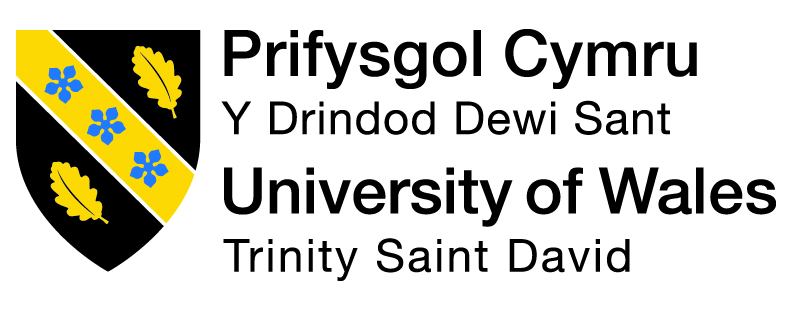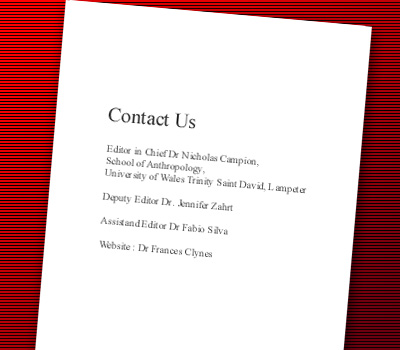We are currently seeking submissions for future volumes of Culture and Cosmos.
Volume 4, No. 1
The Milky Way Dreaming
Review of the exhibition of Australian Aboriginal art held at the Rebecca Hossack Gallery, 33 Windmill Street, London WIP 1HH, 0171 436 4899, fax 0171 323 3182, eMail:Rebecca@hosackgallery.demon.co.uk,
7 July - 2 August 1997.
Abstract
It is difficult to generalise about Australian Aboriginal astronomical art, partly because the pre-European cultures of Australia were as diverse as we might expect in such a vast region, but also because contact with Europeans, such as Christian missionaries, may have affected indigenous beliefs. In addition, the adoption of modern technology, in the form of canvas and acrylics, which makes it possible for Europeans to appreciate this art, necessarily takes it out of its context.
This context, like so much pre-modern western visual art, is religious and/or ceremonial and hence may be seen as alien to the modern secular world-view. Another barrier to the understanding of this art might be the reluctance of indigenous peoples to reveal their most intimate belief systems to outsiders, together with the inability of westerners to understand these beliefs even when they are revealed.
Dianne Johnson writes that 'many observers did not have the expertise to unravel cultural interconnections associated with astronomy. Aboriginal astronomical knowledge was not discrete and separate from other aspects of cultural life. It was interwoven into song, dance, ritual, art and myth, and certain aspects could be owned by one group of people to the complete or partial exclusion of another'.1 This is true - as it is of many cultures.
However, we shouldn't fall into the trap of imagining that Australian Aboriginal cosmology is somehow incomprehensible to contemporary westerners and it would be wrong to overestimate the problems they encounter in this respect; even if the details of pre-European Australian astronomy, both physical and mythological. are dramatically different from western traditions, the principles of its mystical cosmology are familiar to any student of western esotericism. For example, as described by Philip Clarke, 'The perceived existence of the Heavens as an analogue of the terrestrial landscape is common across Australia' and 'The Skyworld was perceived as a place where greater knowledge could be attained'.2 Hugh Cairns and D.F. Branagan have developed a theory of sky-mapping, according to which, 'at certain places and times, Aboriginal people used such markings [paintings and carvings] in relation to day-to-day living, survival techniques, story culture and ceremonial life'.3
If this sounds remarkably like Renaissance Hermeticism, then that might well be the case. As Raymond and Rosslyn Haynes, David Malin and Richard McGee wrote of Aboriginal cosmology:
Explanations that emphasised pattern, order and laws, rather than unpredictable effects, reinforced the sense of the organic relationship believed to exist between natural phenomena and social behaviour. Since many of the legends involved the constellations, the night sky served as a periodic reminder of the moral lessons enshrined in the myths. Like the stained-glass windows of medieval cathedrals, it provided, in effect, an illustrated textbook of morality and culture, relaying the accumulated wisdom of the tribe. In common with most explanatory systems, including Western science, these legends represented attempts to understand, predict and hence to obtain some control over the natural world.4
The authors go on to distinguish, though, the analytical, materialistic and particularising tendencies of western science from the Aboriginal belief that human beings share a spiritual unity both with other species and inanimate objects. This was, of course, the prevalent European outlook until the mid-seventeenth century, around the time of the first contact between Europeans and indigenous Australians in 1613-27. It is also a point of view familiar from the contemporary New Age movement and one which, if we drop the word 'spiritual', many individuals in some branches of science, such as environmental sciences, would instantly understand. We should therefore try to maintain a balance, recognising the distinctions between Aboriginal and western cosmologies without giving in to the feeling that one can never understand the other.
Ironically, some of the conceptual problems we experience in comprehending Aboriginal concepts are derived from the very use of English words to describe them. Howard Morphy points out that the terms 'dreamtime' and 'dreaming' were first used in the late nineteenth century. He writes that 'they arose both out of attempts by early anthropologists to translate Aboriginal concepts into English and out of Aboriginal attempts to explain their religious ideas and values to European colonists'.5
The concept of the 'dreamtime' is frequently presented as something mysterious and unique to Aboriginal culture, when it is clearly analogous to Platonic Being, the eternal realm of Ideal Forms which has often been a central part of western cosmology and which has latterly found a modern home in Jungian psychology. Thus we might look at Aboriginal concepts as not alien but thoroughly familiar to a, if not the, western world view. In this respect we should also note the possibility of antique connections between Aboriginal and western mythology.
The similarity between Greek and Aboriginal, as well as native North American, motifs of the Pleiades as seven sisters is prima facie evidence for a common origin,6 an argument which hinges around the wildly fluctuating dates given by archaeologists to Aboriginal sites; a site dated by one archaeologist to between 116,000 and 176,000 years ago may be dated to between 6,000 and 7,000 years ago by another, using equally rigorous methods.7
As far as the paintings themselves are concerned, while their appeal to westerners is still that of some simple 'authenticity', the commercial exploitation of sacred Aboriginal paintings in the 1950s represents a break between ancient traditions and modern practices and Sandra le Bruin Holmes argues that 'the Aboriginal religious fabric was torn to shreds in the dealers' feeding frenzy'.8 Western prudishness demanded that genitalia be covered up, commercial pressures required less time-consuming techniques and new technologies displaced ancient practices: by 1969 Aquadhere glue had replaced the bush-orchid juice traditionally used to size the bark. However, after her pessimistic account of the destruction of traditional methods and the removal of the paintings from their sacred context, Homes concludes that while the new paintings have no ceremonial significance, they 'can truly be called art'.9
The abstract styles of Aboriginal art are unique and, given that the appeal of such visual imagery is always subjective, can be highly effective. Certainly the immediate impact of the collection of contemporary Aboriginal paintings gathered in 1997 at the Rebecca Hossack gallery was profoundly emotional and it was as easy to appreciate their life and colour in the gallery as to experience the awe of a real starry sky. Astronomical paintings from eight painters were included; Willi Gudupi, Gabriella Possum Nungurrayi, Mary Dixon Nungarrayi, Malcolm Nelson Jagamarra, Clifford Possum Tjapaltjarri, Paddy Jurupurrula Nelson, Jessie Petyarre and Rover Thomas.
In spite of the ideological and technological changes in Aboriginal art identified by Sandra Homes in the 1950s-60s, there is still an evident continuity with the past. Willie Gudupi, for example, was an elder of the Alawa people and hence a custodian of traditional law, a position requiring extensive knowledge of the sacred song and dance cycles performed in sacred ceremonies. Indeed. the abstract images and symbols are all also part of a traditional symbolic language.
Rebecca Hossack's collection of paintings was an impressive one and their impact quite extraordinary.
Unfortunately, although some London astronomical groups were contacted by the gallery with publicity, a great many individuals concerned with astronomy, astrology and astral mythology never heard about the exhibition. Others, the lucky ones, encountered it by chance. There is definitely untapped scope for such work to reach a much wider audience, and it is to be hoped that the gallery will organize a further exhibition when the time is right.
The Rebecca Hossack Gallery is the principal outlet in London for Aboriginal art works. Recent exhibitions have included Dhalwangu Bark Paintings from Yirrkala (28 June - 31 July 1999) and paintings by Warlimpirrnga and Walala Tjapaltjarri (2 August - 4 September 1999).
For further information contact Rebecca Hossack or Tom Greatrex on tel. 0171 436 4899 or fax. 0171 323 3182, The Rebecca Hossack Gallery Fitzrovia, 35 Windmill St., London W1P 1HH .
References
1. Dianne Johnson, Night Skies of Aboriginal Australia: A Noctuary, p. 3, Oceania Monograph 47, The University of Sydney, Sydney, Oceania Publications, 116 Darlington Road, University of Sydney, NSW, Australia 2006.
2. Philip A. Clarke, 'The Aboriginal Cosmic Landscape of Southern South Australia', p. 127, in Records of the South Australian Museum, Vol. 29, part 2, Adelaide, March 1997, pp 125 - 145.
3. Hugh Cairns, 'Aboriginal sky-mapping? Possible astronomical interpretation of Australian Aboriginal ethnographic and archaeological material' in Clive Ruggles (ed.), Archaeoastronomy in the 1990s, Loughborough, England: Group D Publications, 1993, pp. 136-154.
4. Raymond Haynes, Rosslyn Haynes, David Malin and Richard McGee, Explorers of the Southern Sky: A History of Australian Astronomy, Cambridge, Cambridge University Press 1996, p. 11. See also Roslynn Haynes, 'Dreaming the Sky', Sky and Telescope, September 1997, p 72-6.
5. Howard Morphy, 'Australian Aboriginal Concepts of Time', in The Story of Time, ed. Kristen Lippincott, pp. 264-7, London, Merrell Holberton, 1999, p 265.
6. B.A. Frolov, 'On Astronomy in the Stone Age', Current Anthropology, Vol. 22, no 5, Oct. 1981, p 585.
7. 'Scientists turn clock forward on Aboriginal life', The Times, 28 May 1998, p. 13.
8. Sandra le Bruin Holmes, Yirawala: Painter of the Dreaming, London, Hodder and Stoughton 1992, p 132.









